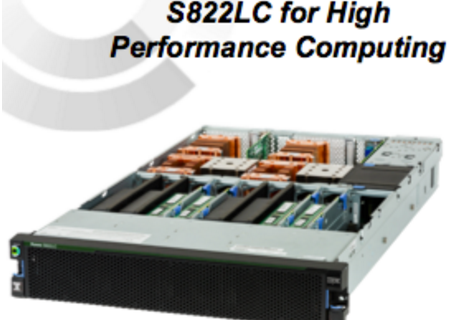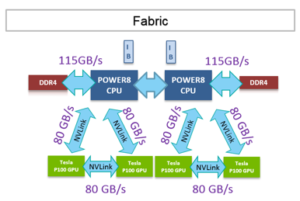Power8 with NVLink Coming to the Nimbix Cloud

Starting later this month, HPC professionals and data scientists wishing to try out NVLink’d Nvidia Pascal P100 GPUs won’t have to spend upwards of $100,000 on NVIDIA’s DGX-1 server or fork over about half that for IBM’s Power8 server with NVLink and four Pascal GPUs. Soon, they’ll be able to get the power of Pascal in a public cloud.
On Wednesday (Oct. 5), Dallas-based cloud provider Nimbix revealed that it will add IBM Power S822LC for HPC systems (codenamed “Minsky”) to its heterogeneous HPC cloud platform. Target markets include high-performance computing, data analytics, in-memory databases and machine learning.
“We are definitely the first public cloud to deploy the Minsky technology and one of the first to deploy Power8 in a high performance high-scalability setting,” said Leo Reiter, CTO and vice president of software engineering at Nimbix. “Obviously what was really interesting on Minksky in addition to Power8 was the Pascal GPUs and we’ve integrated that with our JARVICE platform so it’s a seamless experience for both end users and developers.”
Unveiled by IBM last month, the new Power8 with NVLink processor features 10 cores running up to 3.26 GHz. The processors have higher memory bandwidth than x86 CPUs at 115 GB/s and can have as much as half a terabyte of system memory per socket. There are larger caches per core inside the Power8 processor, and this coupled with the faster cores and memory bandwidth leads to higher application performance and throughput.
The NVIDIA Tesla P100 for NVLink-optimized servers is Nvidia’s most performant GPU yet, delivering a whopping 5.3 teraflops of double-precision performance, 10.6 teraflops of single-precision, and 21 teraflops of half-precision. The accelerator card includes 16 gigabytes of the HBM2 stacked memory with an on-GPU memory bandwidth of 720 GB/s. The Tesla P100 with NVLink GPU in the SXM2 (Mezzanine) form factor, currently only shipping in the DGX-1 and the Minsky platform, delivers 13 percent more raw compute performance than the PCIe variant due to the higher TDP (300 watts versus 250 watts).
 Crucially for many users that Nimbix is targeting with the new hardware, the Minsky platform provides high-bandwidth NVLink connections between the CPU and the GPUs and from GPU to GPU. IBM says the NVLink optimized Power8 servers “enable data to flow 5x faster” than on a comparable x86-based system.
Crucially for many users that Nimbix is targeting with the new hardware, the Minsky platform provides high-bandwidth NVLink connections between the CPU and the GPUs and from GPU to GPU. IBM says the NVLink optimized Power8 servers “enable data to flow 5x faster” than on a comparable x86-based system.
Along with its support for HPC and deep learning workflows, Nimbix says adoption of GPU-accelerated databases is advancing quickly. “Accelerated analytics, like in-memory databases, benefit so much from having the Pascal GPUs as well as the high performance link between them to the point where some customers are getting multiple times performance boost for advanced queries,” says Reiter.
Nimbix is working with Kinetica and MapD to facilitate the use of the NVLink optimized Power servers for database acceleration. Reiter says Kinetica has the ability to scale horizontally across multiple systems so it’s not just being able to take advantage of the GPUs on a single box but to scale across using a high performance fabric like the one at Nimbix.
“So you have both the high density in each chassis where you are going to have four Pascal GPUs with this high performance link, a lot of host memory but then also being able to scale that horizontally to dozens of machines at the same time to be able to do these accelerated databases,” says Reiter.
From its start in 2010, Nimbix has focused on high-performance heterogeneous cloud computing. “While it’s true that the market is heavily tilted toward Intel in terms of the system architecture, we already have the capabilities of running heterogeneous compute, both accelerators as well as central processors, so it wasn’t a technology challenge for us to deploy a non-Intel architecture into our existing cloud,” explains Reiter.
“We’re not requiring that people embrace the system architecture change. We’re not selling architecture here, what we’re selling is turnkey workflows that happen to run in a more optimized way when they’re hooked into the right resources.”
Reiter notes that they’ve been working with Nvidia for a while now and they have multiple datacenters outfitted with Tesla K80s and other Nvidia chips.
Now they’re also partnering with IBM, whom they say has provided and continues to provide a lot of support. “They are extremely motivated to speed Power,” says Reiter, “not just in HPC, but in cloud specifically. And there are a couple reasons. One is that the traction in public cloud for Power is almost non-existent, relatively speaking, but more importantly, even a lot of their customers who are buying Power clusters are asking them for an actual cloud bursting strategy. It’s not just for capacity, but it’s for a lot of these bids now, people are looking at emerging technology in the bids.”
The secret sauce of the Nimbix cloud is the JARVICE container runtime. “The native execution model for JARVICE is containers running on bare metal, so there are no virtual machines,” says Reiter. “There are containers but these are custom-built containers, not Docker. There was too much overhead and complexity and performance loss with getting Docker to run, especially for tightly-coupled, high performance workloads, so we designed our container technology from the ground up, and [with our PushtoCompute technology] we accept ordinary Docker containers as input and convert them on the fly to run natively on the JARVICE platform.”
Asked if they would ever productize JARVICE outside of the Nimbix cloud, Reiter said they are happy to discuss that with anyone who is interested but do not have an immediate play to offer it as an off-the-shelf software product. That said, Nimbix does have select datacenter customers who are trying out the software.
Nimbix’s specialty is enabling turnkey cloud via a software-as-a-service delivery model. It’s not for the user looking to spin up virtual clouds.
“IaaS public cloud is fine for dev-tests of single machine instances,” says Reiter. “Sometimes you want to test out some code and see if it works and that’s great. But when we’re talking about deploying tightly-coupled workflows at scale, deploying the software and tuning the software is extremely complicated.”
“What customers enjoy on Nimbix is they look for the workflow they want to run, they click on it, they specify whatever parameters are relevant to that workflow and they click submit and then their data comes back processed the way they want it to without having to care about ‘How am I going to scale this? How am I going to install it? Am I running the right version? Do I have the right libraries installed?’ JARVICE takes care of all of that – and it’s extensible through technologies like PushtoCompute to enable the onboarding of more and more functionality.”
Every machine in the Nimbix cloud is InfiniBand connected via a Mellanox EDR InfiniBand spine and FDR InfiniBand to the compute nodes. JARVICE also employs distributed block storage and distributed storage over InfiniBand, plus 20GB Ethernet (bonded 10GB) for accessing the internet.
Nimbix expects to have customers using the Minsky platform publicly by the end of this month and prior to that will be conducting benchmarking tests with early-access customers. Initially, demand will likely outstrip availability, and Nimbix says it’s already planning the next step of the expansion, essentially taking orders as soon as IBM can ship.
“The line is there and it’s only going to get bigger,” observes Reiter. “We’re excited to be able service these customers and position ourselves to service more in the future.”










